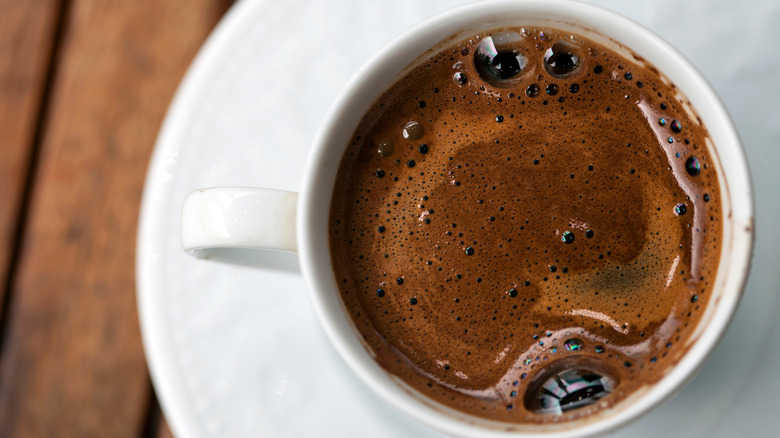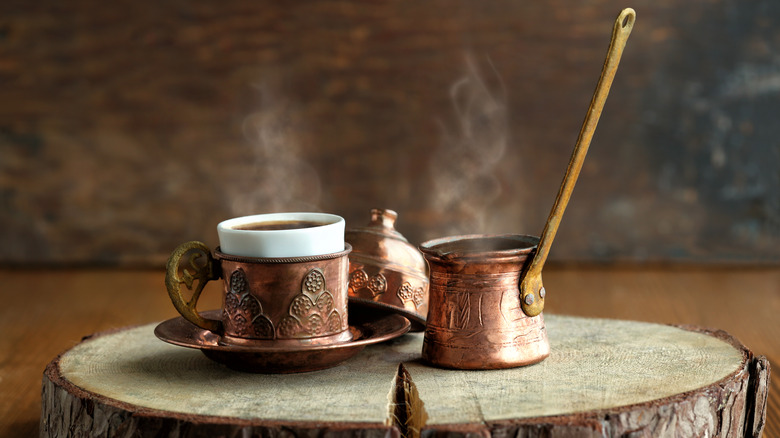The Big Differences Between Turkish Coffee And Espresso
Can't start a morning without a cup of joe? Many feel the same — more than a billion people a day consume coffee worldwide, with 13% of the world enhancing their day with a caffeinating cup, reports Renolon. As such a global beverage, it's no surprise there are a plethora of styles. Now transformed into regional specialties like a Vietnamese iced coffee or a perfectly foamy latte, brewing started with Turks grinding beans and boiling them in a vessel called a cezve. A few centuries later, drip-style brewing took off in France, and the french press was patented in 1852 (via Perfect Daily Grind). It wasn't until 1906 that espresso first appeared, revolutionary for making individual servings, per La Marzocco.
Thankfully for coffee lovers, few preparations fizzled out into history — each method continues to be used today. With a unique flavor profile, serving style, and preparation technique, it's fascinating to sample and compare each type. So let's dive into two methods that both use fine grounds and yield a strongly-flavored cup. Turkish coffee and espresso, what are the differences?
Turkish coffee and espresso utilize different water immersion techniques
A key difference between all coffee preparation styles is how water combines with the grounds. Espresso is a pressure-based preparation method, heating water to a high temperature and quickly forcing it through densely packed beans. Meanwhile, Turkish coffee is a boiling method, combining grounds with water in a heated pot, yielding a unique mouthfeel, notes Coffee Affection.
Additionally, Turkish coffee starts with the beans immersed in cold water, while espresso uses heated water from the get-go. As a result, espresso is a faster brewing method. Especially when Turkish coffee is made traditionally atop heated sand, the coffee mixture will reach a foamy boil in only a matter of seconds, per Roasty Coffee.
The distribution of coffee in water affects the taste, too. Since the grounds are not filtered in Turkish coffee, it has a thicker texture, which can be grainy if not allowed to settle. With a rougher result, the coffee comes across as richer and more full-bodied via Full Coffee Roast. Meanwhile, espresso has a more homogenous texture, with a creamy or even syrupy consistency. The crema, a layer of coffee oils atop the brew, is another trademark of a well-prepared cup, notes Coffee Cantata.
They utilize beans differently
Majesty Coffee notes that Turkish coffee reaches for finer ground coffee than espresso. Such a differentiation imparts a different bean flavor. Since more coffee particles dissolve in water, it can be difficult to impart greater flavor complexity with Turkish coffee. Additionally, the high pressure of an espresso machine can "lock in" delicate flavors lost during longer brewing times. As a result, many coffee connoisseurs consider espresso better for sampling beans, explains Brew Espresso Coffee.
The grind size impacts how coffee is consumed. Espresso is known as a shot for a reason — after a short cooling time, it's downed in as little as three sips. Meanwhile, Turkish coffee must be allowed to settle, and then it's savored over a longer duration. With a bean-laden mouthfeel, tasting and savoring the grounds is a joy of the style. The experience can be furthered by adding spices like cardamom, turmeric, and cinnamon. Not only for their unique flavor, but the spices also impact the texture, per Coffeebrewster. A wide range of roasts can be utilized for either style, although espresso typically favors darker roasts. The preparation method also encompasses more beans roasted specifically for the type (via Majesty Coffee).
Differences in caffeine
There are many factors to consider when delineating caffeine content between the styles. Darker roasts contain less caffeine than other bean preparations, so their propensity for espresso use can decrease potency. However, espresso is usually the stronger of the two styles. A one-ounce pulled shot contains 30-50 milligrams of caffeine, with deviations (a Starbucks espresso is 75 milligrams per shot!). On the other hand, a Turkish coffee clocks in at around 30 milligrams of caffeine per ounce, notes blogger Wolf with an E.
Turkish coffee is typically served in a two-and-a-half ounce demitasse style cup, filled to the brim, explains The Spruce Eats. Meanwhile, espresso is served as a single shot of one ounce or a double shot, which doubles the volume, per Espresso coffee guide. Combined with all of the other factors, a serving of each will initiate a comparable buzz. And why pick between the two? Each style provides its own unique experience — espresso, a swift-drinking cup, and Turkish coffee made for a prolonged savor (via Roasty Coffee).



